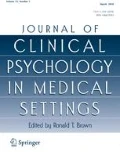Abstract
Distraction is a strategy that has been shown to be effective and safe in the control of pain and distress. We assessed the utility of two simple distraction procedures for reducing children's pain and distress. Three conditions, control, brief film, and short story, were delivered during repeated medical procedures in a randomized sequence to eight young children with cancer. Scores on the Observational Scale of Behavioral Distress (OSBD-R) as well as observer ratings of overall behavioral distress showed that the short story procedure was more effective than either the control condition or the cartoon film. These results argue for the utility of simple parent–child interactive distraction tasks to ameliorate children's procedural distress.
Similar content being viewed by others
REFERENCES
Beauty and the beast (1992). America: Golden Press.
Blount, R. L., Bachanas, P. J., Powers, S. W., Cotter, M. C., Franklin, A., Chapin, W., Mayfield, J., Henderson, M., & Blount, S. D. (1992). Training children to cope and parents to coach them during routine immunizations: Effects on child, parent, and staff behaviours. Behavior Therapy, 23 689–705.
Blount, R. L., Corbin, S. M., Sturges, J. W., Wolfe, V. V., Prater, J. M., & James, L. D. (1989). The relationship between adult's behavior and child coping and distress during BMA/LP procedures: A sequential analysis. Behavior Therapy, 20 585–601.
Cohen, L. L., Blount, R. L., & Panopoulos, G. (1997). Nurse coaching and cartoon distraction: An effective and practical intervention to reduce child, parent, and nurse distress during immunizations. Journal of Pediatric Psychology, 22 355–370.
Ellis, J. A., & Spanos, N. P. (1994). Cognitive-behavioral interventions for children's distress during bone marrow aspirations and lumbar punctures: A critical review. Journal of Pain and Symptom Management, 9 96–108.
Hodes, R. L., Howland, E. W., Lightfoot, N., & Cleeland, C. S. (1990). The effects of distraction on responses to cold pressor pain. Pain, 41 109–114.
Jacobsen, P. B., Manne, S. L., Gorfinkle, K., Schorr, O., Rapkin, B., & Redd, W. H. (1990). Analysis of child and parent behavior during painful medical procedures. Health Psychology, 9 559–576.
Jay, S. M., & Elliot, C. H. (1986). Observational Scale for Behavioral Distress—Revised. Los Angeles: Psychosocial Program. Division of Hematology-Oncology. Children's Hospital of Los Angeles.
Jay, S. M., Ozolins, M., Elliot, C. H., & Caldwell, S. (1983). Assessment of children's distress during painful medical procedures. Health Psychology, 2 133–147.
Jerrett, M. D. (1985). Children and their pain experience. Children's Health Care, 14 83–89.
Kelly, M. L., Jarvie, G. L., Middlebrook, J. L., McNeer, M. K., & Drabman, R. S. (1984). Decreasing burned children's pain behavior: Impacting the trauma of hydrotherapy. Journal of Applied Behavior Analysis, 17 147–158.
Manne, S. L., Bakeman, R., Jacobsen, P. B., Gorfinkle, K., Bernstein, D., & Redd, W. H. (1992). Adult-child interaction during invasive medical procedures. Health Psychology, 11 241–249.
McCaul, K. D., & Malott, J. M. (1984). Distraction and coping with pain. Psychological Bulletin, 95 516–533.
McCaul, K. D., Monson, N., & Maki, R. H. (1992). Does distraction reduce pain-produced distress among college students. Health Psychology, 4(4), 210–217.
McGrath, P. A. (1990). Pain in children: Nature, assessment and treatment. New York: Guildford Press.
Scarry, R. (1993). Sergeant Murphy's busiest day ever. America: Golden Press.
Smith, J. T., Barabasz, A., & Barabasz, M. (1996). Comparison of hypnosis and distraction in severely ill children undergoing painful medical procedures. Journal of Counseling Psychology, 43 187–195.
The Berenstain Bears' big rummage sale. (1992). America: Golden Press.
Varni, J. W., Blount, R. L., Waldron, S. A., & Smith, A. J. (1995). Management of pain and distress. In M. C. Roberts (Ed.), Handbook of pediatric psychology, (2nd ed., pp. 105–123). New York: Guilford Press.
Williams, S. L., & Kinney, P. J. (1991). Performance and nonperformance strategies for coping with acute pain: The role of perceived self-efficacy, expected outcomes, and attention. Cognitive Therapy and Research, 15 1–19.
Zeltzer, L. K., & LeBaron, S. (1982). Hypnosis and non hypnotic techniques for reduction of pain and anxiety during painful procedures in children and adolescents with cancer. Journal of Paediatrics, 101 1032–1035.
Zeltzer, L. K., Jay, S. M., & Fisher, D. M. (1989). The management of pain associated with medical procedures. Pediatric Clinics of North America, 36 941–964.
Zeltzer, L. K., Altman, A., Cohen, D., LeBaron, S., Munuksela, E. L., & Schecter, N. L. (1990). Report of the subcommittee on the management of pain associated with procedures in children with cancer. Pediatrics, 86 826–831.
Author information
Authors and Affiliations
Corresponding author
Rights and permissions
About this article
Cite this article
Mason, S., Johnson, M.H. & Woolley, C. A Comparison of Distractors for Controlling Distress in Young Children During Medical Procedures. Journal of Clinical Psychology in Medical Settings 6, 239–248 (1999). https://doi.org/10.1023/A:1026235620538
Issue Date:
DOI: https://doi.org/10.1023/A:1026235620538




